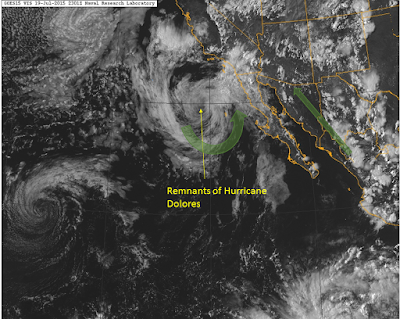 |
| Visible satellite image of the southwestern U.S. at 4:00 p.m. PDT July 19. Green arrows show direction of winds. |
 |
| Some rainfall records in southern California. From NWS San Diego. |
One of our CoCoRaHS observers in San Bernadino County received 3.75 inches of rain over two days (by far the highest amount reported so far that I've seen), with a total for the month of 3.83 inches. Seven observers have measured more than 3.00 inches this month, and another several dozen observers have measured an inch of more. Not bad for an area where the normal July rainfall is just a few hundredths of an inch. Downtown Los Angeles has received 0.38 inches of rain this month. The normal is 0.01 inch.
 |
| 24-hour CoCoRaHS totals the morning of July 20. |
 |
| Total rainfall for the period from ~7:00 a.m. PDT on July 18 to &:00 a.m. PDT on July 20 in southern California. |
As you might expect, that amount of rain caused problems. Many roads were flooded and washed out. Power was knocked out in some communities. A bridge on Interstate 10 between Coachella, CA and the Arizona state line washed out on the eastbound side and was compromised on the westbound side by flash flooding. The I-10 eastbound lanes are closed indefinitely until the bridge is repaired. The westbound lanes were opened again on Tuesday (July 21). About 27,000 vehicles normal travel this section of I-10 every day.
 |
| Firefighters stabilize a pickup truck that drove into washed out I-10 bridge. The driver was rescued. Photo credit: CalFire Riverside |
 |
| Map showing location of damaged bridge on I-10 and section closed (yellow). |
On Sunday (July 19) the baseball game between the San Diego Padres and the Colorado Rockies in San Diego was first in a rain delay (6th time in history) and then eventually called off. It was only the second time in Petco Park history (since 2004) that a game has been rained out. The last rain-out occurred in 2006.
The rain did little to relieve drought conditions. The rain, while significant, is just a very small drop in a very large bucket. With evaporation rates on the order of 0.20 to 0.25 inch per day what didn't run off will soon be back in the atmosphere. The water balance chart from CoCoRaHS station CA-RV-21 in Riverside, CA shows just how little dent the recent rain made in the water deficit since May 1.
Drought conditions over the western U.S. and particularly California remain unchanged. They are likely to remain unchanged until the wet season begins in the winter, and then only if precipitation occurs regularly and is well above normal.



No comments:
Post a Comment